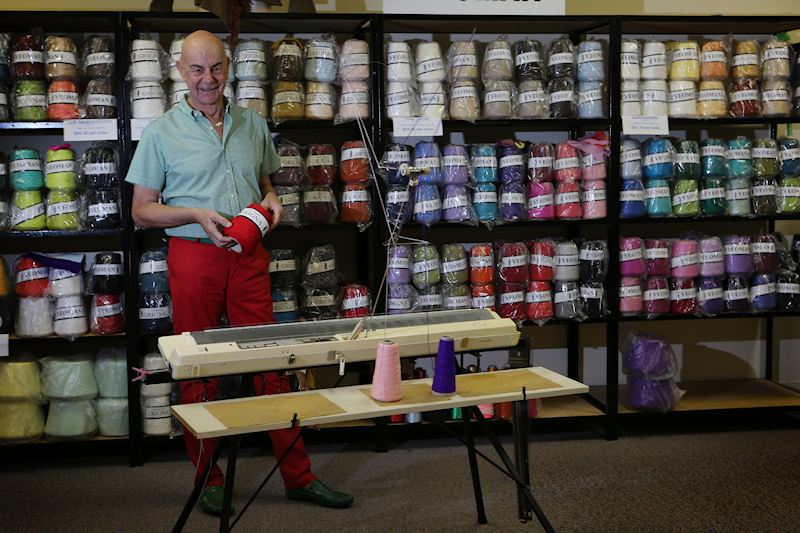Dormani Yarns do not trade, sell second hand machines but Tony our expert on knitting can help you by advising what type of machine would be best for your requirements and what to look for in a second hand machine. Once you have purchased your machine Tony can also provide lessons on how to use your machine.
Originally there were three brands of knitting machines imported into Australia
Brother Knitting Machines
Singer Knitting Machines
PASSAP Knitting Machines
Since 2000 the major suppliers stopped importing into Australia new Knitting Machines, saying the market was too small to warrant the investment.
There are new knitting machines that are manufactured in China that are being imported into Australia.
Parts for Brother Machines are still available and for older machines substitutes are available.
For general information the following are the model numbers for Brother Knitting Machines:
Electronic Machines:
KH 970, KH 965, KH 950, KH 940, KH 930, KH 910 & KH 900
Punchcard Machines:
KH 894, KH 892, KH 860, KH 840, KH 836, KH 830, KH 820, KH 680
If you are interested in taking up machine knitting for the first time a good second hand machine might be the way to go. These machines range in price from as little as $50 to several hundred depending on the model and condition of the machine.
BUYING A KNITTING MACHINE
You need to consider the following when purchasing a knitting machine:
1. GAUGE – This is the size of the needles and how close together they are on the machine bed.
The gauge of the machine will decide what yarn you can use in regards to yarn thickness and type.
There are 4 different types of machines when considering gauge:
(a) Fine Bed Machine (3.6mm)
Uses very fine yarn to produce very fine knit fabric that is typically seen in manufactured clothing.
(b) Standard Bed Machine (4.5mm)
Uses a variety of yarns and thicker type yarns can be used by selecting every second needle. This is the most popular of the knitting machines available.
(c) Mid-Gauge (6.5mm & 7mm)
Uses regular to thicker yarns and garments look much like hand knitting. These machines were designed to combine the best of the standard and bulky machines.
(d) Bulky Gauge Machines (8mm, 9mm & 11mm)
Use thick yarns and looks like hand knitting.
Next to consider is the type of machine:
2. PATTERN SYSTEMS
There are basically two types of systems
(a) Punchcard
(b) Computerised/Electronic
(a) Punchcard machines read a special piece of graph treated card that has holes punched in it that make the stitch design/pattern to be knitted. This system is limited to a 24 stitch per row pattern.
(b) Electronic machines have a “computer” built in that can be programmed. These machines can have stitch designs/patterns that are the full width of the needle bed per row.
3. WHICH MANUFACTURER MACHINE TO BUY
In Australia there are basically three manufactures imported by dealers:
Brother Knitting Machines
Singer Knitting Machines
PASSAP Knitting Machines
4. WHICH KNITTING MACHINE MODEL
Once you have decided on the manufacturer then decide on the model that will best suit your needs.
5. RULES FOR PURCHASING A KNITTING MACHINE
1. BUYER BEWARE
2. When in doubt go to point 1
3. Ask for the actual name and model number of the machine
4. Always ask to see the machine or at least actual photos of the actual machine
5. Do not think that since you are buying from a dealer they are being honest
6. Use is – is USED it is NOT new
7. Ask the following questions and if the seller gets irritated move on:-
(a) When the machine was last cleaned. This tells you how the machine was maintained
(b) If it has not been used in a while ask where it has been stored. Moisture and dust are NOT friends of knitting machines.
(c) When was the last time the sponge/retainer bar replaced. Ask to see it – if it is really flat this is really old = machine not well maintained.
(d) Ask if the seller is the original owner, if not do they know how many owners the machine has had.
(e) Ask what type of oil has been used on the machine. If general purpose oil then the machine will probably need a thorough service to remove gummy areas.
8. If in doubt refer to point 1
9. Do not get caught discussing the original cost of the machine it has nothing to do with current pricing.
The following are general definitions for the levels of quality of knitting machines:
LIKE NEW – Good to excellent condition. You would only need to dust it off and start knitting. It has a new sponge/retainer bar and thoroughly cleaned. This machine should have no yellowing.
EXCELLENT – Good to excellent condition. Expect to clean it and maybe replace the sponge/retainer bar. Again the machine should have no yellowing.
GREAT/GOOD – good condition expect to clean it and replace the sponge/retainer bar. Some yellowing maybe present.
GOOD/FAIR – Expect to clean it, replace the sponge/retainer bar and expect minor repairs and servicing of the machine. Yellowing will be present.

